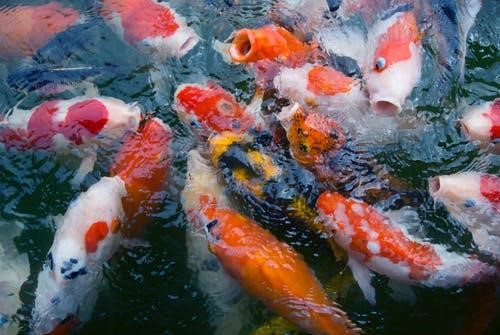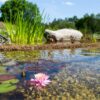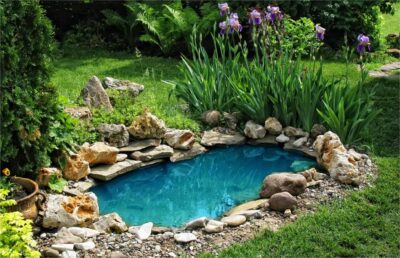What is graceful, regal, and can be found in ponds and water gardens all over the world? Of course, the koi! These huge, colourful fish have been around for hundreds of years and are an excellent addition to any garden pond or large water feature.
It’s an undeniable fact that fish in a pond dramatically improve every garden or courtyard’s aesthetics. Garden ponds with koi fish are absolutely breathtaking and give a one-of-a-kind touch to every home. However, keeping koi fish alive and safe in their garden pond habitat can be difficult.
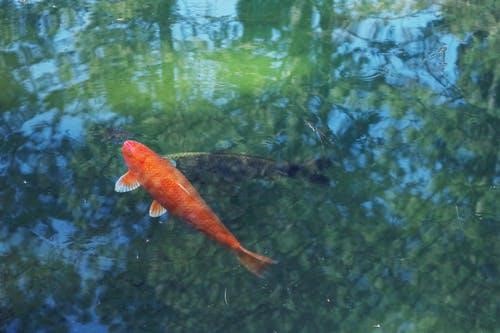
The soothing sounds of waterfalls and the exotic and colourful fish aren’t just for fun while you’re on holiday at your favourite beach. Koi keeping is increasingly becoming a mainstream and successful hobby.
Recent advancements in koi pond filtration, as well as the growing success of water gardening, helps in the expansion of the koi keeping sport, which was not very famous before that. As a result of this development, there are now many books, videos, and magazines solely advertising the hobby of koi keeping.
This koi pond care article will provide you with additional tips to help you improve your koi pond and become a seasoned koi fish pond owner.
The very first koi breeding started in Japan. The Japanese bred koi fish to excellence, and several varieties were valued in royal family collections and immortalised in royal artworks. Koi was not very well known until the 1900s in Europe, the United Kingdom, and the United States.
Origin Of Koi Fish
Koi are a kind of ornamental fish as the descendent of the carp. Chinese farmers farmed carp in rice paddies in the 1600s, a tradition that spread to Japan, where the Japanese found unusual colour differences in some of the carp and bred them, giving rise to the koi genus. Koi only come in red, white, yellow, and blue shades initially, but they’ve now been coming in all the colours of the rainbow.
Koi are still one of the most common varieties of fish in the world today, and they are readily available regardless of where you live. Pet koi are available in pet shops and come from commercial farms in Europe, Asia, and the United States. You may also purchase koi from specialized koi breeders and farms.
Building a Koi Fish Pond
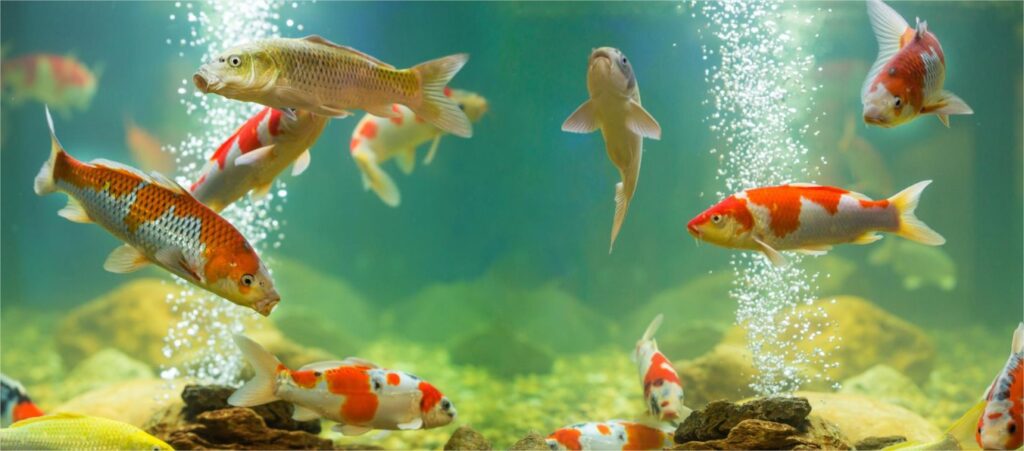
Starting a new koi pond can seem to be a difficult challenge. There’s a lot of learning required, and your progress could save the lives of a dozen or so fish. It can be absolutely scary!
Koi ponds are also known as “Swimming Pools with Koi” or “Large Fish Baths.” In the reservoir, there are no bricks, stones, or aquatic plants that might damage the Koi. To discourage predators from wandering into the pond and attempting to eat the Koi, the Koi Pond is built with straight downsides (no steps).
A Koi Pond is not a “landscape” thing like Water Garden Ponds, but rather a pool or large fish tank built especially for raising Koi. Koi ponds are biologically and micro-filtered with ultra-effective, easy-to-clean filters, with mechanical filtering performed by pond skimmers, bottom drains, and bottom drain pre-filters.
The Koi Pond has a minimum depth of 4′, a typical depth of 5′-6′, but it can be much deeper. It can also provide external aeration technologies to allow for direct, unobstructed views of the koi.
An aeration mechanism provides oxygen to the Koi Pond, and the water rotates with an external pump. There is no high-voltage electrical equipment inside the pond.
Koi Fish Care: For Beginners
Koi fish have a fast growth rate and can grow to be very large. To be comfortable in a pond, each koi should have about 50 gallons of water as they mature. Smaller koi can be housed in an aquarium or holding tank indoors, but you must ensure that they do not outgrow the aquarium as they grow.
It’ll come time to put the koi in a pond at some point!
How Much Do Koi Ponds Need to Be Maintained?
Weekly maintenance of a koi pond requires just a few minutes. A Koi Pond without waterfalls is a peaceful, quiet pond with lovely Koi gliding around in pleasant silence. The aeration device provides all of the oxygen in the Koi Pond. The pond can be illuminated at night with underwater lighting so that the pond owner can see the lovely Koi.
The pond does not need draining because the bottom drain and pond skimmer continuously remove waste and debris.
Tips To Maintain Koi Fish Ponds
First and foremost, you must make some careful preparations. Building and maintaining a koi pond is not complicated, but if done incorrectly, your fish’s wellbeing will be jeopardized, and your investment will be squandered. The first step is to choose a suitable spot, followed by determining the size and depth of the pond.
Then figure out how much water the koi pond will hold. This will determine the size of the filtration system required. Finally, you’ll need to construct the koi pond and any landscaping that goes with it. Only at this stage should you consider purchasing koi fish. They should, in theory, be able to go straight into their permanent habitat.
Let’s talk about what to do until your fish is ready and the water has been properly cycled.
FACTORS TO KEEP IN MIND BEFORE INTRODUCING KOI TO THE POND
Koi fish come in a wide range of colours, shapes, sizes, and fin configurations. Choose your fish carefully, and most people would want to try a lot of them. Generally, you can buy smaller fish and wait for them to mature. When determining how many koi are suitable for your pond, keep in mind their future size.
The following are some metrics to keep an eye on if you want your koi to flourish :
WEEK ONE: LET THEM ADJUST
- When adding koi to a new pond, it’s crucial to give them time to adapt and settle before dumping them in.
- You’ll need to contain them in tanks with a capacity of 50 gallons per three fish and eventually add pond water to their holding tanks. It’s worth noting that this holding tank also needs to be filtered properly.
- Fill the pool with tiny bits of pond water until it’s about half full.
- Over the course of a few days, do this. Place your koi in plastic fish bags and let them float for at least thirty minutes to acclimate to the water temperature until everything is ready. This move is critical because it helps to avoid the shock of a temperature change.
- Allow them to rest for a day after they’ve settled into their new pond before attempting to feed them. After their feeding spree has subsided, add in what seems appropriate for them to eat within five minutes and scoop off any leftovers.
- It’s worth noting that if they haven’t adjusted to their new pond yet, they may refuse to feed.
WEEK TWO: WATER FILTERATION & QUALITY
- Your koi should be more relaxed now, and you should start making arrangements to move them to the pond as soon as possible.
- Make sure you have a filter that will disinfect the water while still encouraging the growth of beneficial bacteria.
- UV lights and other extras can help keep your water clean and safe, particularly if you have algae overgrowth issues, so look for those features when filter shopping if you have any concerns.
- Aside from filtration, you’ll want to be sure the water is at the right temperature and is well-shaded.
- Koi prefer shade areas and do not thrive in excessively warm areas; additionally, if the pond is overexposed to the sun, algae will overgrow.
- Koi like water that is between 65 and 75 degrees Fahrenheit, but they can accommodate certain variations.
WEEK THREE: TIME TO MOVE KOI INTO THE POND
- After three weeks, if everything looks fine, you can move your fish to your koi pond, but four weeks is preferable. You’ll be putting the plastic bag holding the koi into the pond this time.
- Be sure the tank water is the same temperature as the pond water. Instead of using a net to remove your koi from the bag, simply open it on the surface and hold it. Allow the koi to emerge from the bag at their own pace.
- Although you can keep the fish in the holding tank for more than 3 weeks, you should not switch them until that time has passed.
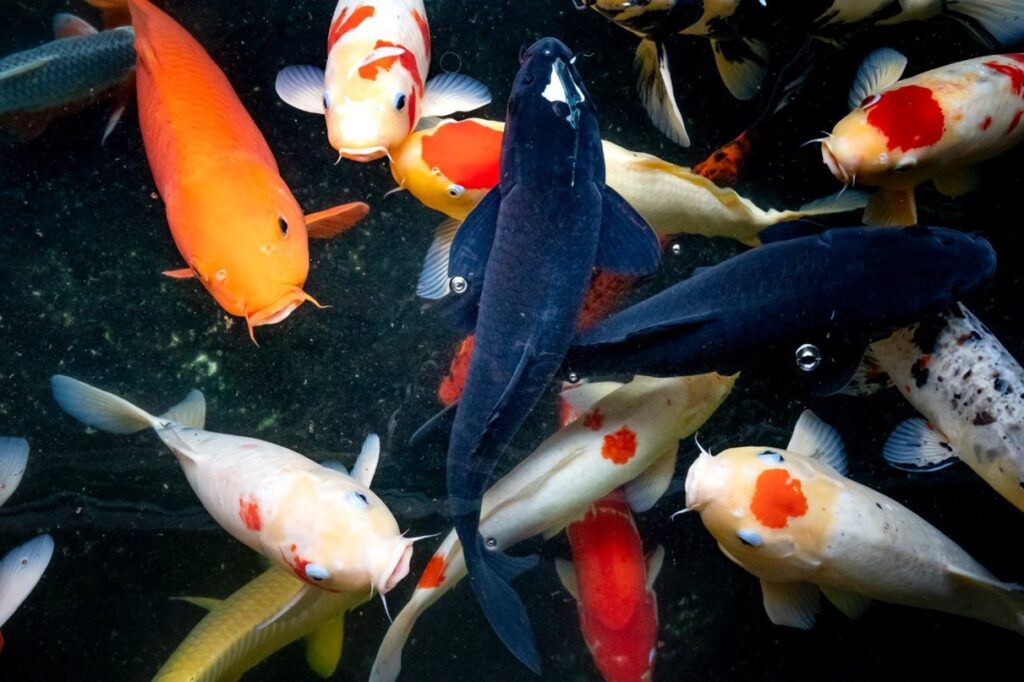
How To Keep The Koi Fish Pond Clean
Although you might see koi ponds with angular rocks and embellishments, this is not a good idea.
Koi are well-known for digging and scratching against their ponds. Sharp rocks or other foreign objects will injure the fish, resulting in diseases that can spread to the other fish in the tank.
When building the pond, use flat, circular decorations and rocks, and inspect them constantly to ensure no breakage has happened and no sharp items have dropped into the pond.





